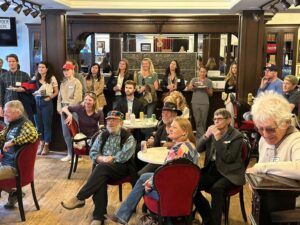Last year, when the Telluride Foundation awarded the AhHaa School for the Arts a $25,000 grant, the impact of that grant was much greater than supporting arts programming and scholarships for low income children. We can measure the results of this grant not only by the social impact of a robust arts program, but also by its economic impact: the $25,000 grant was recirculated in the community when AhHaa School employees spent their pay checks on groceries, rent, and entertainment, and it helped to pay for and maintain local amenities, galleries and art work that attract more tourist dollars into the region.
We are in a period called the “new golden age of philanthropy,” where funders and donors are increasingly interested in the effectiveness of their giving, including the social and economic impact. As a result, the Telluride Foundation has completed an analysis to measure our economic impact, finding that our grants, initiatives, and other operations have generated a total of $63 million in economic returns for the region.
The Foundation’s analysis is premised on the fact that its grants and initiative support help generate new jobs in the regional communities, which in turn produce higher household incomes. This income expansion has what economists call a “multiplier effect,” as spending by those who have gained jobs and additional income stimulates additional job creation and income for those providing goods and services to the initial beneficiaries. In addition, much of this additional economic activity generates tax revenues for the federal, state and local governments.
HOW THE TELLURIDE FOUNDATION IMPACTS THE ECONOMY
The discussion below explains how the Telluride Foundation measures its economic impact, which in many ways is in the same manner as a standard business. The impact of the Foundation’s grants, initiatives and local spending are leveraged in the following ways:
- New money brought into and spent in the region.
- The amount of additional value from the recirculation of that spend.
- Additional spending by visitors on local events and activities occurring because of the Foundation’s community enhancements.
- Creating self-sufficiency by supporting human service and social needs.
- Supporting innovation and entrepreneurship, which leads to new jobs, new money, and ultimately a more sustainable economy.
- Basic Economic Impact – New Money Brought to the Region
Positive economic impacts are created by bringing new money to the region. Entities that bring wealth from outside into a community, like sales of manufactured goods, purchase of real estate, or destination tourism, comprise the basic component of the local economy. The non-basic, or local service component includes the entities that serve local residents and businesses.
A community foundation like the Telluride Foundation functions much like a manufacturing company. The Foundation’s goods and services are effectively new money brought into the community through fundraising, which creates local spending and start-up activities that enhance community improvements and attractiveness. Based on annual revenues and expenditures, the Telluride Foundation is one of the largest basic sector businesses in the region. Over the past 16 years, the Foundation has raised over $40 million in direct cash contributions and distributed over $36 million in grants to regional nonprofits and in initiative expenditures.
A conservative analysis of donor contribution patterns shows that more than 80% of the money raised annually by the Foundation is new money brought into the region. This is due to the fact that many of the contributors to the Foundation are second homeowners. The Foundation raised $6.7 million in 2016; therefore, a total of $5.4 million of new money was brought to the region in 2016.
This is a conservative estimate because it could reasonably be argued that Foundation giving by locals represents funds that would have otherwise been placed in non-local investments or with non-local charities, and thus deposited outside the local economy.
- Re-Circulation of Spending in the Region
The amount of money raised by the Telluride Foundation is then distributed through grants and initiative expenditures. A conservative estimate, based on similar economic studies, is that the Foundation’s economic multiplier is 1.75. For every dollar spent by the Foundation, it gets multiplied 1.75 times due to local re-circulation of the money. The Foundation is one of the few businesses in Telluride that has virtually no non-local spending. With few exceptions, the Foundation exclusively supports local endeavors and locally owned and operated businesses.
(1) Grant Funds to Nonprofit Sector
In 2016 the Telluride Foundation granted $2 million in cash grants to local nonprofits. Those grant funds were in turn spent locally to pay for operating costs such as salaries, rent, and utilities and local services providers. Employees in turn use local wages to pay for food, rent, healthcare, and entertainment.
(2) Foundation Operational Expenditures
In addition to grant expenditures, the Foundation also incurs its own expenses for salaries, rent, accounting and audit services and events. In 2016 alone, the Foundation spent over $900,000 for these non-grant expenses. Again, the Foundation estimates that over 90% of the non-grant expenses were re-circulated locally.
- Additional Spending by Visitors/Tourism
Telluride Foundation activities are critically important to the maintenance and expansion of Telluride’s tourism industry. Telluride attracts a highly educated and sophisticated customer. Along with a resort experience, the availability of arts and culture and the richness and diversity of our community are at the heart of what makes Telluride an attractive community to our visitors. Other resort towns are acutely aware of the role of arts, culture and heritage in retaining upscale visitors. Thus, these towns have invested in and supported such amenities as the Music Tent and Wheeler Opera House in Aspen, the new Art Center and the Museum of Western Art in Jackson Hole, and the Vilar Performing Arts Center and Ford Amphitheatre in Beaver Creek/Vail.
Travel industry statistics indicate that tourists who engage in cultural, arts, heritage, or historic activities – all of which are at the heart of our mission – spend on average 40% more than other tourists. Arts and cultural organizations receive a large part of Foundation grants funds each year. Research has found, for example, that every dollar spent by arts and culture nonprofits generated $1.65 in additional, direct household income and 45-cents in additional, direct federal, state and local revenues.[1]
- Creating Self-Sufficiency
Much of the Foundation’s expenditures are directed to support social and human service needs, resulting in individual and family self-sufficiency. Resort communities are locations with high living costs and limited access to critical resources like healthcare and mental health services. This creates enormous pressure, including economic, on the local workforce and families. The Telluride Foundation is a leader in funding for and an innovator to address these issues and reduce their negative economic impact.
For example, the Good Neighbor Fund was created to address short-term financial emergencies by the local workforce. A grant from the Good Neighbor Fund might allow a local employee to keep her job or maintain her housing by paying for a car repair, a medical expense or the monthly rent. Opportunities created and/or supported by the Telluride Foundation, such as the Good Neighbor Fund, Skippy(school based dental program), sliding-fee scale medical and mental health programs, and food banks help the local workforce to be self-sufficient, especially during financial hardships.
- Economic Impact from Innovation & Entrepreneurship
Telluride Venture Accelerator (TVA) is an example of the Telluride Foundation’s strategic initiative to support the regional economy, which has historically been based on the volatile sectors or real estate and tourism. The thesis of TVA is to support eight new local businesses and help them to reach a size of $10 million in revenue annually. At that size and with the type of business that TVA is working with, there are generally 10-30 jobs created per company at an average salary of more than $70,000. The result would be the creation of at least 50 regionally based, high value jobs at an average of more than 50% Telluride’s current average medium income (AMI). Beyond the obvious economic impact of TVA are the additional community benefits, including greater social mobility for the local workforce, more opportunities for youth who want to return here, and increased earning potential, enabling the purchase of homes that might otherwise become short term rentals or unoccupied full-time.
The Foundation’s efforts to build the infrastructure necessary to attract innovation and entrepreneurship will ultimately lead to a stronger, more stable economy. This evolution of the local economy from resource extraction, real estate and tourism, to, today, entrepreneurship, is a viable, less volatile way for resort towns to preserve their authentic culture and community.
TOTAL IMPACT OF THE TELLURIDE FOUNDATION
Using the factors outlined above, the economic impact of the Telluride Foundation in the past 16 years has been substantial. They include the following:
- Importing $32 million dollars to the region.
- Re-circulating new money within the region, producing direct and indirect impacts.
- Supporting elevated spending by visitors for arts/cultural/sports activities and events.
- Maintaining attractive amenities without tax spending.
- Supporting community members and the local workforce, thereby reducing adverse social services expenses.
- Community cohesion among visitors, locals and second home owners.
- Providing infrastructure to move from a real estate and tourism based economy to an economy built on innovation.
In summary, the total economic impact of the Telluride Foundation over the past 16 years has been over $63 million. The Telluride Foundation, through its incredibly generous donors, helps to create and sustain a highly functioning, caring, supportive, amenity-rich and economically-expanding community. That is good for everyone.
[1] Americans for the Arts. “Arts & Economic Prosperity III: The Economic Impact of Nonprofit Arts and Culture Organizations and Their Audiences,” 2007, https://www.americansforthearts.org/pdf/information_services/research/services/economic_impact/national_findings_summary_report.pdf.



